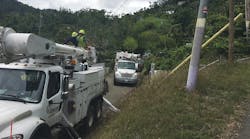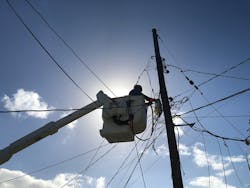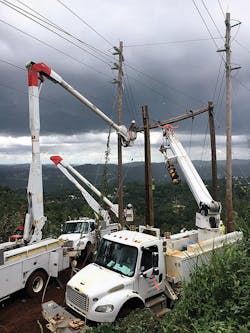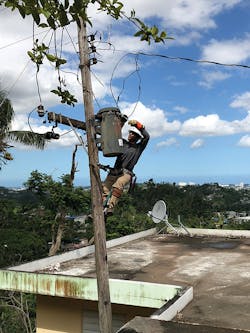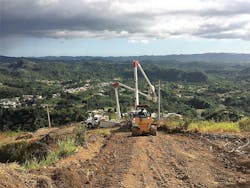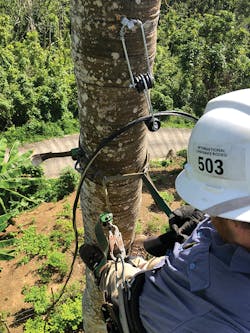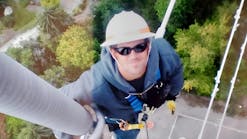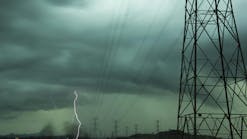Over the last 18 years, Eric Eskra has restored power following tornadoes and ice storms in the United States. However, nothing could have prepared him for his experience in Puerto Rico following Hurricane Maria in September 2017. “Everywhere you look, you see the effects — the buildings, the vegetation, the high-line poles, the distribution — nothing went untouched,” said Eskra, supervisor of electric operations for Division 3 at Ameren Illinois’ Lincoln operating center. “Seven months after the storm, we saw workers clearing brush and boulders from the windy roads up the mountain. It looked like the hurricane happened just a week before.”
Like Ameren, Arizona Public Service Co. (APS), Transpower in Florida, International Brotherhood of Electrical Workers (IBEW) Local 104 (on behalf of Line Construction Services, under Consolidated Edison Inc.) and Georgia Power were just a few who sent electric crews to help rebuild infrastructure and restore power in Puerto Rico.
Despite the heat, humidity and grueling working conditions, these mutual-aid crews had experiences they will not soon forget. “It affected me like no other storm,” Eskra noted. “Being around for as long as I have, most of the time when we leave a storm, we know it will be finished. On this storm, we were told from the get-go that our wave was the last wave [for Ameren]. As the clock was ticking and getting closer, reality struck me that some of these people would be out of power for a long time still.”
Working in Remote Regions
Ameren sent crews from both Missouri and Illinois to Puerto Rico in three waves. The utility sent its first wave of linemen just before New Year’s Day 2018. In early March, Eskra joined the final wave of Ameren’s restoration effort. “As soon as we caught wind of [Ameren sending crews], I was a bit leery because no one had been down there yet, and they had been without power for so long,” Eskra noted. “After I got my shots, I had the opportunity to go on the third wave. Even though I had months to ponder it, read the news and see what was going on down there, the closer it became to the time, the more nervous I got about leaving my wife and kids behind for a month.”
After landing in San Juan, Eskra traveled in a charter bus that dropped him and his crew members on the road down the hill from his hotel. “It snowed in St. Louis the day we left, and
it was 90°F when we got to Puerto Rico,” Eskra said.
As he hiked up the mountain carrying a 24-day supply of clothes and bags, he wondered what was in store for his crew during their time on the island.
Ameren Missouri and Illinois linemen restored power and rebuilt infrastructure in a mountainous, remote section of San Juan. When the crews rolled up on the scene in their bucket trucks, residents cried and cheered. Up to that point, they had not seen many line crews in the northeastern part of the island, which had been hit by the eye of the hurricane.
Waves 1 and 2 focused on rebuilding the three-phase power up the mountain for the feeders, but the third wave focused on the single phase to get the taps up and the services back on. As such, Eskra’s line crews had more interaction with the customers than the other two waves. “We were able to throw a fuse and see the customers get back on, and we were going into the neighborhoods and working at their homes,” Eskra noted.
The crews worked 16 hours a day, kicking off each day with a 4:30 a.m. safety briefing and then hanging up their hooks at 9 p.m. Sometimes Eskra would attend another briefing at the end of the night and not return to his hotel until late in the evening. To stay safe during the restoration, Ameren linemen abided by the same rules in Puerto Rico as they do in Illinois or Missouri. “Backfeed was a topic because of the amount of generators, and we used isolation as one of our work practices,” Eskra said.
The linemen also had to deal with the local insect and animal population — from swarms of bees to iguanas. “The iguanas are two or three times worse than we see squirrels here,” Eskra observed. “Luckily, we never saw them get up the poles.”
Good communication was paramount during the entire restoration process, especially because the crews were moving around from one area to the next. Also, teamwork was crucial to the success of the mutual-aid effort. “Everyone was on board and helping each other,” Eskra noted.
In San Juan, the island is dominated by a large mountain range and the roads are more like alleyways, according to Eskra. In remote areas and tight backyards, the linemen had limited access, and they had to work with whatever materials they could find. “We had to make do with what we had,” he said. “A lot of people swapped materials, and in some cases, the guys were like MacGyver and had to just make an electrical connection and move on.”
Consisting of about 80 linemen in each wave, Ameren crews had to prioritize their work to get the most bang for the buck. For example, they had to make sacrifices to get as many customers on as possible at one time. If they only had half a dozen transformers, they had to use them in mission-critical areas that needed to be restored first.
For the most part, Ameren did everything it could to take care of its line crews material-wise, Eskra said. Case in point: The utility shipped the linemen’s line and bucket trucks to San Juan. It took three weeks for the vehicles to make it from the east coast of Virginia to the island of Puerto Rico. The utility also sent other equipment such as Polaris Ranger utility vehicles and Kubota tractors with loaders and other attachments. “Ameren did a tremendous job taking care of us,” Eskra said. “I have to give them so much credit to be able to go behind the scenes and have the insight.”
Wrangling Vegetation
San Juan’s power system was similar to but also different than what Eskra’s crew is used to. For example, the voltages were different, and the lack of protection on the lines was an issue. Without the one-shot capability, the lines came out of the substation hot without any regulators or reclosers. “It looked like it was put together by an electrician, because they don’t have the rules and standards that we have,” Eskra observed. “As far as basic line work, we didn’t see anything too out of the ordinary.”
On the tap, most of the structures were wood, but the linemen encountered concrete on the three-phase power. They also faced their share of vegetation issues. By the time the storm hit, the vines in the rainforest had grown over the facilities that were down, and the vegetation had to be cleared before power could be restored. “Think about what your yard would be like after seven months without cutting it and there was a wire down — the overgrowth would be tough,” he explained.
Because the growing season in Puerto Rico is almost year-round, after seven months, the linemen had to use machetes to chop their way to the downed wire. “One pole we had to reach was in a valley, and there was no road to access it,” Eskra recalled. “The Puerto Rican power company had to build a road just so we could get to the pole.”
Community Connection
Eskra may have faced a language barrier while working in Puerto Rico but was amazed by how quickly everyone could communicate, at least to understand, using hand gestures. Despite trying to communicate in a different language, the families offered genuine hospitality to Eskra and the other linemen. For example, at least three families invited Eskra and his family to come back to Puerto Rico and stay with them at their home.
Also, even though Ameren Illinois provided linemen with a box lunch every day, Eskra said he only ate four of them the entire time he was there. “The local churches and communities would come together and have a huge potluck for us on a daily basis — and these people really had nothing,” he said. “Every day we would have coolers of water, and they were always offering us soda. The people we were with in the mountain were the nicest people I have ever met.”
One memory that really stood out to Eskra happened two days before he was ready to return home. He and his crew had been working in the same area and had gotten to know one family. “They would be out every morning at their fence waving American flags,” he said. “My internal goal before we left was to get power restored for this one family. It would be like closure for me knowing that we accomplished something.”
That morning, his team got a call saying they needed to wrap up work by 10 a.m. They were tasked with closing a fuse to pick up 20 houses, including that of the family they had gotten to know. Regardless of whether the fuse held, they had to depart the area and board the plane on time. “When the guys closed that fuse and it held, it left me knowing we did absolutely everything we could for everyone we could,” Eskra said.
Before they left, the crew finally was able to get some rest and relaxation. “By the beginning of the third week, it was like Groundhog Day with the same thing every day,” Eskra said. “We gave our guys some time off to go see the ocean and get some stuff to take home to their families to keep their morale up.”
Witnessing Total Destruction
Like Ameren, APS also sent crews to Puerto Rico. In December 2017, lineman Troy Smith had the opportunity to join a mutual-aid mission to Puerto Rico with APS. Because of issues with the truck barge, however, the trip was delayed until January 2018. Before he left for Puerto Rico, Smith did not have any expectations for his six-week stretch on the island. “I didn’t know if we would sleep in a barge, tent or truck,” said Smith, who has been with APS for the last 20 years and now works as a crew foreman. “We knew we would be working distribution, but we didn’t know where nor what our conditions would be like when we got there. We knew we would be there for six weeks and generally working 15 hours a day with 12 days on, one day off.”
Smith flew from Arizona to Florida to San Juan, where he stayed at the Wyndham Rio Grande, which was booked the day before he left. He arrived in Puerto Rico at night, but the next day, when his crew was mobilized, he saw mass destruction.
“There was stuff down everywhere — buildings and trees — and guys were working all over the place,” Smith said. “Most of the houses didn’t have roofs, and the enormous trees had huge trunks but not a leaf on them. There were tons of plants, banana trees and vines everywhere.”
Smith even heard the hurricane-force winds were so strong a truck literally disappeared into the jungle. Following Hurricane Maria, residents stretched tarps over their damaged buildings and homes. They depended on generators until their electricity could be restored.
Most of the residents had an auto-transfer switch, so they were accustomed to living without power. To isolate these community members from the rest of the grid, the linemen flipped a remote transfer switch.
Make It Work
To restore power to those who could accept it, the linemen packed all their tools onto crew trucks, which were barged over from Port Charles, Louisiana, to San Juan. Smith joined about 45 other linemen, who had a wide range of experience in different departments from sub-transmission to distribution to transmission.
Back home at APS, Smith runs a distribution crew. In Puerto Rico, he and his fellow linemen stayed in one area at a time to restore power.
“Multiple people were working on circuits, so we took one feeder and worked the whole thing to make sure there were no problems,” Smith said. “We would fix an entire neighborhood and energize it from the feeder to the services to the transformer to the weather head. We did every part from start to finish.”
Where the crews were working, the entire neighborhoods were very dense and spaced out. To store their materials, they shared a lay-down yard with TECO Energy and Florida Power & Light Co. On restoration, the linemen encountered aging equipment. “There were very old transformers that were very archaic, and they had a different wire size,” Smith observed. “We did a lot of Hendrix cable, which was jacketed due to all the trees and open conductor with no primary overhead. The secondary was the same, but you could tell it had been years without maintenance.”
Unlike at home, the linemen could not simply request a certain item from the warehouse. Instead, they had to be creative and work together to find the proper supplies and equipment. “We were sourcing for materials,” Smith said. “If we didn’t find one transformer, we rebuilt it by opening the can, replacing the bushings, fixing it and rehanging it. We didn’t rehang one new transformer during the entire time we were there. None of them showed up.”
In most cases, the linemen replaced concrete with concrete, steel with steel and wood with wood when it came to structures. However, the key difference was none of these poles had any smart grid devices on them, as is common stateside. Also, the overall wire size and construction of the infrastructure was different than in Arizona, and the crossarms were aluminum instead of wood or fiberglass.
During the restoration, the APS linemen traveled at night to reach the work location for the next day. The crews started at 5 a.m. and finished at 7 p.m. “They didn’t want us working at night, so — a lot of times — we would travel from the job site to the lay-down yard and then go to the hotel,” Smith said.
In the beginning, the linemen stayed at the Wyndham, but then they moved to a Sheraton halfway through the restoration process to be closer to old San Juan, where they were working. Overall, they were able to energize four separate neighborhoods and got to know the local community members.
It was Smith’s first time in Puerto Rico, and he enjoyed meeting the families and children, and seeing how much they appreciated the linemen. “They were awesome,” Smith recalled. “They were very gracious and would have given us the shirts off their backs. They cooked us all lunch and brought us coffee. They were very excited to see us and, for the amount of time that they were out, it was unbelievable to see how happy they were. Life just kept moving on, and they didn’t skip a beat.”
Protecting Line Crews
While in San Juan, Smith said the APS crews had to contend with rain every day. “It continued to rain for hours on end,” he recalled. “We had raincoats, but we were still soaking wet, and we had to just deal with it and keep on working. It was also very humid, so we would dry out eventually.”
Working in the jungle environment was a world apart from the Arizona desert climate back home, Smith noted. “It was a challenge working in the rainforest due to the footing,” he said. “We had to make sure everyone was safe and accountable, and look out for everyone.”
To stay safe, the linemen started their workdays with a safety meeting to check all the points and ensure nothing was different. “We verified with our team leads and management team that we owned the clearances that were given to us from [Puerto Rico Electric Power Authority] and did our normal clearance protocols,” Smith said. “We wanted to make sure that we didn’t overlap with another utility, and we stuck with our safety procedures.”
While in San Juan, he met linemen from all over the U.S. — from New York to Wisconsin to Florida — who also were in Puerto Rico to lend a helping hand. After his time was up, Smith returned home to his family. “It was good at the beginning but kind of rough,” he noted. “We have three kids, and it was hard with the time change and their schedule with school and sports. We had limited communication during that time, but they understood why I was gone, to help the people of Puerto Rico.”
Going Out on the Storm
While many of the volunteers to restore power were journeymen linemen, apprentices also traveled to Puerto Rico to help. For example, Lucas Fowler, who has been in the line trade for three years, had the opportunity to join a mutual-aid crew through Transpower Construction Services Inc., a subcontractor under Fluor Corp.
“It was memorable to be so young and go on a big storm like Maria,” Fowler said. “I worked with guys all over the United States, and I’ll have lifelong friends from all over that I met down there.”
Because the lines were built so long ago, Fowler and the other linemen had to rely on old-school work methods, he said. “All of the power lines all over the island were way too old and out of date, and that’s why most of it was destroyed in the hurricane,” Fowler observed. “Transmission and distribution crews worked a minimum of 12 hours a day, if not longer.”
At the end of the day, they returned to living conditions, which were surprising at first, he said. “We had a really nice condo, but it was not furnished — no bed, no microwave, no stove, no fridge — just an empty tile-floored condo,” he said. “We slept on cots.”
From Florida to Puerto Rico
Meanwhile, Eric Bowden, a lineman for IBEW Local 104 out of New Hampshire, worked in the outer part of San Juan on some very steep hills. Using a pickup truck with a boom on it, he and the fellow linemen fixed services and focused on the secondary work in the region. “We put the services back to whatever houses that could be put back together,” Bowden said. “Some of the homes were down to just their foundations due to the hurricane.”
After working down in Florida for the initial wave of the hurricane, Bowden wanted to join the crews who were traveling to the Virgin Islands or Puerto Rico to aid. “I heard it was pretty bad, and I finally got my chance to go at the end of January with a contractor,” he said. “I was working with a friend of mine who wanted to go also, so we went together.”
After flying directly into San Juan, Bowden spent 43 days on the island. Before he left, he had heard stories about the devastation caused by Hurricane Maria. “The electrical system was really out of date, and with the hurricane hitting, it made it even worse,” he said. “It made it hard to figure out things because there were no circuit maps and, if there were, they were not very accurate. We were given the source, and it would say that it starts here, this is your line, and call us when it heads back.”
He says it was hard living in San Juan as far as the day-to-day living conditions. While he and other linemen were fortunate enough to stay in a hotel being rebuilt from the hurricane, a lot of fellow workers stayed in tents or camps.
When he first arrived, he and other linemen were transported to the showup for contractors. Because everyone was working at that time, Bowden was able to see the entire area without trucks. He then got the rundown of what to do in different scenarios and what to expect on the job.
The voltages were pretty much the same, but the lines ran through the forest and never along the roads. “That made it very difficult,” Bowden said. “Not just because of the terrain, but because the spans would be over 1000 ft long.”
If wire went down in the middle of the woods, it was likely to be fully grown over and inaccessible. Therefore, linemen had to obtain new wire. In most cases, it was for a neighborhood, but other times, it was for a mountainous location.
Bowden recalled obtaining the full circuit of a substation on a hill. “It was very steep, and the primary went up the hills,” he said. “It was weird how it was all built. It’s like the first person who lived there started at the top of the hill and then built the lines up randomly, and then started to build further down.”
Because of the hurricane, high winds knocked down poles in the middle of the woods and blew over transformers. Once Bowden and the other linemen got the primary back up, they focused on a lot of the secondary work. Often, they had to troubleshoot to figure out what went where and which services needed to be run. “If there was a pole in the middle of the woods, we had to figure out how to set it and get out there to assess the damage,” Bowden explained.
While he and other linemen climbed a lot of poles, Bowden also used his drone, which helped with inspecting lines and figuring out how they were routed. He even used his drone to pull wire by starting with a thin rope or fishing line, bringing up another rope, and then pulling the wire with that rope. “It was a process but the best way to do it,” he said.
Specialty tools were almost nonexistent. For the most part, Bowden used old-school methods by going out in the woods with a chainsaw and some climbing gear.
Like other linemen in Puerto Rico, he encountered his share of rain. However, the rain would only last about 10 minutes at the most where he was working, so they worked in between rain showers. “A lot of the times, you could see it coming, so you would plan ahead,” Bowden recalled.
Overcoming Challenges
In Puerto Rico, Bowden traveled with about 14 other linemen, who would start their days boarding a bus at 5 a.m. and then get back to the hotel at about 7 p.m. or 8 p.m. He had a total of three days off, and he invited four of his good friends to visit the island and surf during his downtime.
While he has worked as a lineman for Local 104 for a decade, Bowden has never traveled out of the country for work. On this storm, he was working with Line Construction Services, which was working under ConEdison, to restore power. “I would always recommend it,” Bowden said. “You learn a lot from not only the type of work going on but also from the people who are there, as well. Everyone was welcoming to us, even though they had been out of power for six or seven months. They help you and make you lunch, and make sure everything is going well for you.”
Bowden felt like his crews were able to accomplish a lot with what they were given. “We didn’t have a lot of stuff that was right for the job, but we were able to make it work,” he noted. “The biggest issue was the stock because there was nothing to make it 100%. We had problems finding little things like connectors and wire that you normally wouldn’t even think of.”
Having the right-sized connectors was a significant challenge for the linemen. “You get this wire from the company, and you put it up, and you don’t even have the connectors that work,” Bowden explained. “There was a lot of bartering between companies. At the beginning of the day, you would try to figure out what the other people had, and if you didn’t have the stock to do it, you tried to find a different way.”
Providing Mutual Aid
Nationally recognized for emergency storm response in its service area and outside of it through mutual-assistance calls in the U.S., Georgia Power also sent linemen to Puerto Rico to provide aid. The utility, which has sent employees to help restore power in Texas, Oklahoma, Illinois, Pennsylvania and New York in the past, sent 40 employees to Puerto Rico.
As part of a larger Southern Company effort, the employees departed Georgia between mid-January 2018 and mid-March 2018 to help with the rebuilding and restoration activities in Puerto Rico. For example, Southern Company’s incident management teams arrived on the island before the utility’s line crews arrived, and they stayed on-site throughout the restoration. Another restoration team then was deployed to the island after the first team returned home.
Since the hurricane first hit Puerto Rico, Georgia Power has followed the situation closely. As part of the Southeastern Electric Exchange and an industry mutual-assistance effort coordinated through the Edison Electric Institute, Georgia Power played a key role in restoring power to thousands of people in many of the remote and hard-hit parts of the island.
For example, Jesse Atkinson, crew leader for a Georgia Power distribution line crew, joined the first wave of the restoration effort. While preparations had been made in the city for his team’s arrival, conditions were still difficult, and the part of the electric system where they worked still needed significant repairs. Case in point: Bulldozers had been used to clear roads and shove debris down the mountains, so the crews could get through. “We did a great deal of walking just to reach areas inaccessible to our trucks,” Atkinson recalled. “Our crews saw extensive tree damage, downed wires, broken poles as well as damaged homes and businesses across the area. Mudslides and washouts also caused extensive damage to roads, and a great deal of material had been destroyed or swept away.”
While in Puerto Rico, Georgia Power crews slept in rooms at a local hotel around Mayaguez, and they ate hot catered meals for breakfast and dinner at the staging area. In addition, the linemen were given snacks and beverages to take with them to their remote work locations.
On a typical workday, the linemen worked 16-hour shifts in Puerto Rico. During that time, crews replaced hundreds of poles and more than 1000 spans of wire. They also helped to repair other damage in the mountainous terrain while navigating around powerline pathways, which were often inaccessible by the bucket and line trucks. “Working conditions were difficult, with long days and hard work; however, we are used to that,” Atkinson said. “We do a lot of storm duty, both at home in Georgia and through many other mutual-assistance deployments in the United States. Each has unique challenges, such as working in freezing weather for ice storms or working in hot, humid areas with frequent rain and difficult terrain, like in Puerto Rico.”
Old-School Line Work
The difference between providing mutual aid in Puerto Rico versus other locations is the electric system on the island was older and had much longer spans between poles. Also, it was damaged severely by the storm, including mudslides. At the end of the day, though, it was the same kind of work — putting up poles, wire and other equipment — and doing it safely. “We worked with our experienced crew members, our engineers and supervisors, and those from the island to ensure we understood the equipment, knew the open points and worked to safely make repairs as quickly as possible,” Atkinson said.
To improve productivity, the Georgia Power teams used drones to efficiently assess damage in hard-to-reach areas. Like Bowden from Local 104, they also used drones to carry a leader rope across inaccessible areas. Overall, however, much of the work was basic and included a lot of climbing, rigging, setting poles, restringing wire and restoring power.
Throughout the restoration effort, Atkinson and the other Georgia Power linemen worked in remote and difficult terrain with treacherous driving conditions. Because so many portable generators were in operation, they had to constantly be aware of backfeed. In addition, they had to keep their truck brakes from overheating while driving down the mountains and avoid the poison ivy-like rash from the pica-pica plant. “We always put safety first; working outdoors and with high-voltage electricity requires a constant safety focus, so that was not unusual,” Atkinson said.
He and his line crew stayed in Puerto Rico for 60 days, longer than most stateside deployments. Given the travel and amount of work that had to be done, however, he said it made sense. “The people there were great and very appreciative of our efforts,” Atkinson noted. “No one likes to be without power, and here they had been without power for months.”
Atkinson also enjoyed meeting linemen from other parts of Georgia and other Southern Company subsidiaries. “Some of my particular memories are around the guys working hard together,” he said. “On a rare break, we were taken on a trip to the coast for a dinner. While there, an incoming storm brought 25-ft waves, which caused additional restoration challenges.”
While Atkinson mostly worked with his Georgia Power team and other linemen from Georgia, he also had the opportunity to work with utility crews from Minnesota and other locations on several occasions. The linemen also partnered with the Mayaguez police department, who helped to clear traffic on narrow mountain roads.
Atkinson said he and his team were part of a larger effort of lineworkers who were willing to do hard, dangerous work in a safe manner to get life back to normal for so many Puerto Ricans. “It was important, gratifying work to see how much difference our efforts made for families there,” Atkinson said. “At the same time, you realize how much we take for granted, and you don’t realize how much you’ll miss your family and friends until you are gone for that long. It was an experience I won’t soon forget.”
